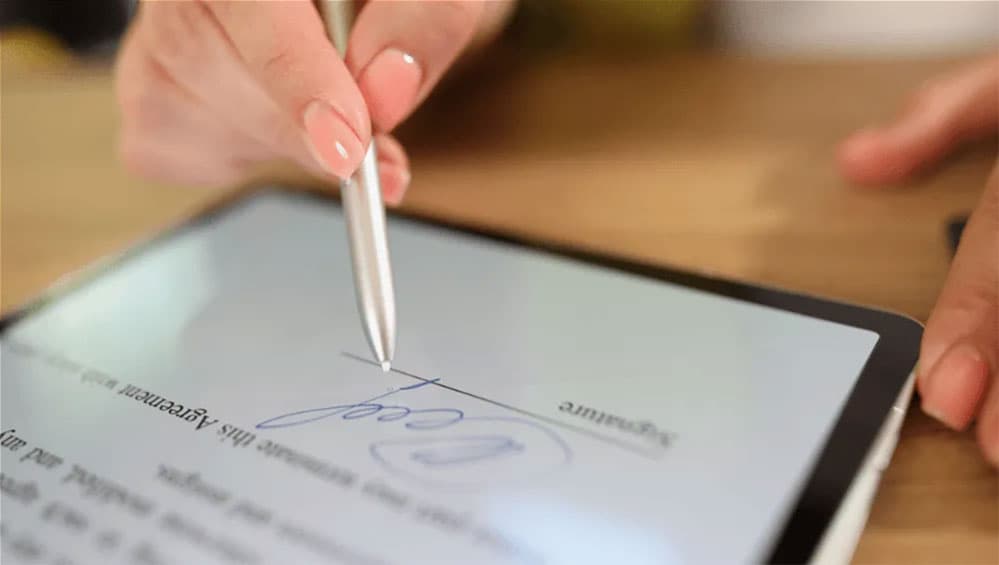Electronically signed documents: A complete guide

Published:
Understanding electronically signed documents
In today’s rapidly evolving digital landscape, the world of paperwork and signatures has undergone a significant transformation. The days of printing, signing, scanning, and posting documents are quickly fading into the past.
Picture this. You’re sitting at your desk with a mountain of client paperwork to sign and send. There’s a couple of ways you can do this. Print off the document, sign it yourself, and scan it over to the client to do the same. Alternatively, you could post the signed document to the client, the round-trip taking at least five days.
Both ways take time, money, and require various pieces of equipment (and patience!)
The scenario is made even more difficult when you don’t have access to your equipment, your business is cutting costs, or you’re working remotely.
Enter electronic signatures.
In just minutes, you can be sending documents straight away via an eSignature platform. With an easy interface, cloud storage, and unlimited free users – it’s a no brainer!
As almost every industry makes an effort to shift towards digitisation, solutions like signing documents electronically are on the rise. But, are electronically signed documents easier and can everyone use them?
This guide will walk you through everything you need to know about electronically signing documents.
What are electronically signed documents?
Some people are under the illusion that electronic signatures are complex and hard to understand. However, electronic signatures (e-signatures), are simply the digital equivalent of traditional handwritten signatures. They are used to signify the approval or acceptance of a document in the same way as putting pen to paper.
Electronic signatures have become increasingly popular in recent years because of their convenience, security, and efficiency. E-signatures are legally binding and are accepted in most parts of the world, making them a go-to choice for businesses and individuals.
How do electronically signed documents work?
E-signatures work by using digital encryption technology to link a signature to a specific document. This isn’t as technical as it sounds. When a document is electronically signed, a unique digital fingerprint and audit trail is created, ensuring the document’s integrity and authenticity.
The electronic signing process is simple, often involving just a few clicks, making it incredibly user-friendly.
Are electronic signatures secure?
A common misconception about eSignatures is that they are not as secure as traditional handwritten methods. But in actual fact, a physical paper document isn’t as secure as an electronic one for a few reasons:
- Handwritten signatures are easily forged.
- A document could be amended after the signing takes place.
- A paper document can be easily lost, damaged or stolen.
Electronic documents have a full audit log which breaks down every action that takes place on the document. You can trace who signed, where they signed, and most importantly, prevent anything from being changed after the signing takes place. Plus, the document itself is stored in the Cloud, preventing it from being lost or damaged.
The legal aspects of electronically signed documents
Are electronically signed documents legally binding?
Another common concern regarding digital signatures is their legal validity. However there’s over twenty years of regulation to support this! Thanks to the adoption of international laws and regulations such as the ESIGN Act and (UETA), electronically signed documents are widely recognised as legally binding.
The importance of verification and authentication
To go one step further in ensuring the legality of electronically signed documents, there are processes in place for verifying the identity of your signers. This often involves the use of authentication methods, such as a one-time password, biometrics, or email verification.
Benefits of electronically signed documents
Efficiency and time-saving
One of the greatest advantages of electronically signed documents is that they save time! No longer do you have to wait for a document to be printed, signed, and physically delivered. E-signatures allow you to instantly sign documents online, reducing the turnaround time for important contracts and agreements.
Cost-efficiency
When you wave goodbye to printing, postage, and paper costs, you are left with significant cost savings for your business. A win-win. Find out how much you could save!
Environmental impact
In a world that increasingly values sustainability, eSignatures are a welcome initiative. They drastically reduce paper consumption and carbon emissions associated with traditional paperwork, making them a step toward a greener and more eco-friendly future.
Using electronically signed documents
Popular tools for eSignatures
There are many online platforms and software providers which offer eSignature services so you may feel spoilt for choice! Adopting an eSignature solution such as Signable provides a user-friendly interface and robust security features to ensure a smooth e-signing experience.
The e-signing process
So how do you send a document to be electronically signed? The process with Signable is simple:
Sending a document electronically
- Upload the document: Start by uploading the document you want signed onto your Signable account. Not registered? Try our 14-day free trial and start using electronically signed documents in minutes.
- Add signatories: Enter the email addresses of the people who need to sign the document.
- Place your fields: Drag and drop your signature, date, text or upload fields onto the document.
- Send for signature: Send the document to all the signatories. They will receive an email notification from Signable with a link to sign the document electronically.
- Completed document: Once all signatories have added their eSignatures, you will receive a copy of the signed document alongside a full audit trail and certificate of completion.
How to sign an online document electronically
- Open the email from [email protected].
- Click the link in the email.
- Fill in the required fields e.g. address, date, upload.
- Finally, fill out the signature field, & choose the type of electronic signature you’d like to use:
- Type your name with your keyboard – it will generate a signature for you.
- Upload an image of your signature.
- Draw/write your signature with a mouse or trackpad.
Submit the document and that’s it!
Security considerations
Protecting your eSignature
Keeping your eSignature secure is vital. Here are some tips to keep it safe:
- Use strong, unique passwords for your e-signature accounts.
- Enable multi-factor authentication whenever possible.
- Be cautious of phishing attempts or suspicious emails related to your e-signature service
Ensuring document security
E-signature platforms use robust security measures to protect your documents. Data encryption, access control, and audit trails are just some of the security features you can expect.
eSignature use cases
What documents can I sign electronically?
Here are just some of the types of documents you can sign electronically:
- Employment contracts
- Tenancy agreements
- Student enrolment forms
- Service for hire contracts
- Accounting contracts
- And more!
E-signatures in different industries
The great thing about eSignatures is that they are not limited to any specific industry. Electronically signed documents are used in various sectors, including:
- Real Estate: Streamlining property transactions with electronic signatures.
- Finance: Facilitating the quick approval of loans and financial agreements.
- Education: Simplifying the student admissions process.
- Legal: Speeding up the signing of legal contracts and documents.
The future of electronically signed documents
The adoption of electronically signed documents is only set to increase in the coming years. As technology continues to advance, we can expect even more secure and user-friendly document signing software.
Ready to make the switch to electronic signatures?
Sign documents with ease, boost efficiency, and go green. Try Signable’s 14-day free trial today and experience the future of document signing.
Get started in under 60 seconds
Check out our free 14 day trial and start sending documents now.
